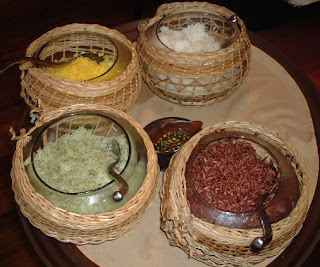
1
.
THAILAND AND THE CUISINE
Thailand is one of the most diversified and exciting countries in the globe, with the contrast between quiet countryside living and the bustle and hustle of city life. So does Thai cuisine - it can be bland or so exciting that it burns people's tongues.
Thai cuisine has fallen into the limelight in the global epicurean stage for the past few decades, and developed into a permanent love affairs for gourmet lovers in recent years. Basically, Thai cooking is light, with the use of fresh and herbal ingredients, ensuring a balance of texture, color, spices, and five fundamental tastes blended seamlessly to create a range of unique flavors for people's appreciation and palate.
Thailand is primarily an agricultural society. The tropical country, granted with fertile soil and warm climate, is ideal for growing crops such as rice, fruits and vegetable; also for raising animals and catches from the Gulf of Thailand and the Andaman Sea. Rice is central to the Thai culture and rice farmers are the backbone of Thai agriculture; glutinous or 'sticky' rice is popular in the north and northeast, while plain rice is common in the central plains and south. Kap khao, or various dishes, is eaten with rice.
To add flavor to the plain rice, a spicy, and fairly runny, varied curry dishes are the top choices among the Thais. During the sixteenth century, significant new ingredients were introduced to Thailand, such as chilies from South America, curries from India and Persia, and noodles from China. Since then they were subtly modified and refined to their own individual tastes, colors, and textures into the signature of being uniquely Thai.
Thailand has four regions, the North, the Northeast, the Central and the South. Each region has its own distinct ethnic people and culinary method. In the North, with a strong Burmese influence, curries are thinner and less pungent then those in central and southern, without the feature of coconut cream. Typical northern dishes are nam-prik ong, a curry dip served with vegetables and crispy pork skin and naem (sour pork sausage); khao-soi, a curry broth with egg noodles and meat; and gaeng-hang-lay, pork curry seasoned with ginger, tamarind and turmeric.
The Issan (or Northeast), with heavy Laotian influence, features the herby and down-to-earth recipes. Typical northeastern dishes are som-tum gai-yang, a spicy shredded green papaya salad eaten with grilled marinated chicken; laab, a spicy minced pork, chicken or beef dish eaten with glutinous rice; and haw-mok, steamed ground fish curried souffle in banana leaf wrapper.
The Central plains includes Bangkok, the center of culture in the country, with knowledge from all regions as well as the palace cuisine added with heavy Chinese influence made the central cuisine a celebration for all. All the classic Thai curries are eaten in the area; yum, spicy salad, mixed with any kind of ingredients such as vegetables, meat and seafood are renowned dishes; tom-yum, spicy and sour soup, of the popular tom-yum-goong or spicy and sour prawn soup is one of the national dishes; deep-fried dishes and stir-fried dishes that are commonly cooked with the best ingredients, served with the best long-grain rice, are popular. Fruits and vegetables carved with hours of preparation and artistic presentation into a dish decoration represented the delicacies of ahan chao-wang, palace cuisine, enhances the pleasantries of Thai cilinary arts.
The South, with close influence from Indian, Malay and the Muslim community, features furious curries with coconut cream incorporated with the yellow chilies and fiery birds-eye chilies; however, Muslim curries are usually cooked with ghee or yogurt without the present of coconut cream. The South is benefited from the long coast line of two seas, the Andaman Sea and Gulf of Thailand, where fresh fish and seafood are best to be grilled, barbecued, fried or simply steamed. Poo-phad-pong-karee (stir-fried sea crab with yellow curry powder), goong-phad-prik (stir-fried prawns with chili) and goong-ob-wunsen (baked prawns with glass noodles in a clay pot) are southern traditional favors. Seafood is also fermented and preserved as a flavoring, such as kapi, the salted, fermented and sun-dried shrimp paste, and other fermented seafood sauces, are made in quality throughout the southern provinces. Khao-yum is a southern rice dish typically served with fermented fish sauce and fresh vegetables.
Cuisine from four regions mingle well in the country and regional fares are far more available than before; there are recently more elegantly decorated establishments specializing in the refined royal Thai cuisine awaiting the patronage from tourists.
Food is an appreciation. Thai cuisine is a celebration. For gastronomic adventures fit for all epicureans, Thailand is where you need your presence.
The writer can be reached at thaisclub@yahoo.com
Copyright (c) 2006 MDS. All rights reserved.